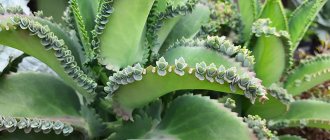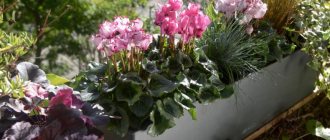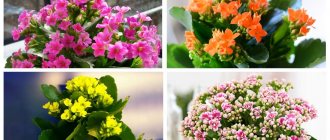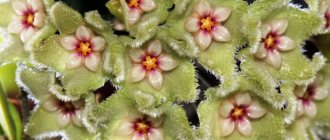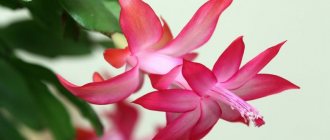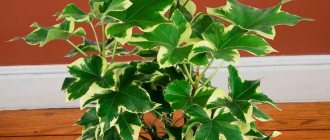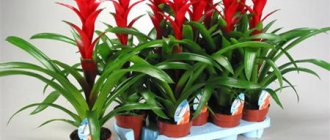Kalanchoe is one of the tropical exotic flowers that came to us from South America and Africa. It has long earned its popularity due to its beautiful flowering and medicinal abilities. In nature, Kalanchoe is represented by many varieties and varieties that belong to the group of succulents. In our article we will tell you about the most popular varieties, and also give some tips on growing them in your apartment.
What does Kalanchoe look like?
It is a genus of plants with enormous diversity. Kalanchoes differ greatly from each other in height, leaf size, stem shape and even color. It is best to study Kalanchoe in a photo. It is noticeable from them that the genus includes trees 4 meters tall and bushes 20 cm tall.
The plant is rich in shades. The leaves and stems range from bright green to blue-blue. There are both round and sharp leaf shapes.
Possible problems
The most common problems when growing Kalanchoe:
| Problem | Possible reasons |
| The shoots stretch out and the leaves begin to turn yellow | Lack of lighting |
| Wilting, drying of leaves | Air temperature too high |
| Stopping growth | Lack of nutrients Most often observed after active flowering. |
| Soft, fragile stems | Overwatering or planting in soil that retains water well. |
| Lack of flowering | Most often - non-compliance with wintering conditions. |
Varieties
If you need Kalanchoe with medicinal properties, then there are only three varieties:
- Kalanchoe Degremona, it has elongated leaves with a sharp end and teeth along the edge. It does not bloom, but reproduces well, producing babies on its teeth.
- Kalanchoe pinnate is a flowering plant with small pink-yellowish flowers. This house doctor is grown to produce medicines for the treatment of surgical, gynecological and dental diseases.
- Kalanchoe Blossfeld - It blooms with small white, red or orange flowers. The flowering period occurs in winter and spring. It has very distinctive leaves, they are fleshy and shiny.
Other species are also popular for growing Kalanchoe at home, requiring a minimum of plant care skills. But these three varieties have medicinal properties.
Types and varieties of Kalanchoe
Despite the variety of existing varieties, four main types of Kalanchoe are cultivated in indoor floriculture:
| View | Description | Height (m.) | Leaves |
| Pinnate | Grown as an ornamental or medicinal variety. It reproduces with the help of babies that form on leaf plates. | Up to 1. | Oval in shape, thickened with rounded teeth, upper ones imparipinnate. |
| Felt | So called for its resemblance to a chocolate soldier and cat ears. The inflorescences have the shape of a panicle or umbrella. The corolla of the flower is purple or red. | 0,3. | They are covered with a viscous felt coating, have a pointed ovoid shape, and fit tightly to the erect stem. |
| Blossfeld | Breeders have developed several varieties with yellow, scarlet, pink and orange flowers. The wild ancestor has red inflorescences. | Under natural conditions up to 0.6, in room conditions – 0.3. | Glossy, egg-shaped, located on erect stems. |
| Degremona | Perennial. Elongated pink-violet flowers are collected in a large inflorescence. It reproduces by rosettes located along the edges of the leaves. In most cases, the baby rosette takes down aerial roots and falls away from the mother plant; if it gets into the soil favorably, it takes root on its own. | Under natural conditions up to 2, and at home – 50 cm. | Green or gray with purple or brown speckles. |
How to properly collect and store
The plant grows all year round. If you need a leaf, you can come up at any time and pick it. If Kalanchoe is being prepared for planned treatment, then the preparation is approached scientifically:
- stop watering, wait a week;
- cut off the lower leaves;
- wash the raw materials thoroughly in running water and wipe dry;
- keep in the refrigerator in the bottom fruit drawer for 5-7 days.
This step-by-step collection process allows the beneficial properties to develop and accumulate. Properly prepared leaves can be used to make infusions, ointments and other dosage forms.
Home care
This plant is not at all capricious, it is not difficult to care for, the main thing is to provide it with enough light, so it is recommended to place the flower on the south side. If there is not enough light, you need to create artificial lighting for it. The optimal temperature for growth is 16-26 degrees. Watering should be done sparingly as the soil in the pot dries out. Do not be afraid that the flower does not have enough moisture; its leaves accumulate water and retain it for a long time. A medium-sized pot for this plant should be chosen so that the plant’s strength is directed not to the development of roots, but to the stem, foliage and inflorescences.
Help: After the end of flowering, it is recommended to create a “rest” for the plant. It is necessary to reduce the daylight hours for the flower by placing it in the shade. This will enable it to reserve strength for future flowering. Also during this period you need to feed less and leave watering the same.
If your plant does not bloom for a long time, then first try to reduce the frequency of fertilizing. Usually this method solves this problem.
Medicinal properties
Such a rich chemical set determines the long list of medicinal properties of Kalanchoe:
- Promotes rapid regeneration.
- Destroys pathogenic microorganisms and demonstrates good bactericidal and bacteriostatic properties.
- Inhibits the development of the inflammatory process.
- Stops minor bleeding, has a beneficial effect on blood flow, so it can help even with varicose veins.
- Solves problems of skin diseases.
The plant is used to treat female diseases; it promotes rapid healing of erosions, tears and cracks. Compresses with leaves help improve well-being in case of prostate adenoma and prostatitis. Children over 1 year of age and pregnant women can instill diluted juice into the nose for a runny nose.
Kalanchoe can be included in comprehensive weight loss programs. It helps activate the digestive system and tones the body.
Pests and diseases
The most common diseases and pests that affect Kalanchoe include:
- scale insects;
- aphid;
- spider mites;
- mealybugs;
- gray rot;
- powdery mildew;
- late blight;
- stem rot.
To get rid of most diseases, it is recommended to treat the plant with fungicides. You also need to check how dry and warm the environment around the succulent is. In some cases, the problem can be solved by improving lighting and applying complex fertilizing.
How to identify root and stem rot in succulents and save the plants
In what form is it used for treatment?
After harvesting, Kalanchoe can be stored in different forms:
- infusion;
- ointment;
- tincture;
- decoction;
- juice.
For long-term use, it is better to make tinctures with alcohol; they retain the properties of plants for up to 1 year. You can add the plant juice to odorless olive or sunflower oil.
Recipes for preparation and use
Rules of application
In order to prepare a high-quality medicinal product, you must adhere to certain rules:
- For treatment, use a plant no younger than 2 years old. This Kalanchoe has already been filled with useful substances and will provide more effective benefits.
- A week before cutting the leaves, stop watering the flower, which will help concentrate more healing components in it.
- The lower leaves of the plant have the greatest healing power.
- Cut leaves cannot be washed; they can only be wiped with a damp cloth.
- They are wrapped in natural fabric and placed in the refrigerator for 10 days.
- After the expiration of the period, the juice is crushed and squeezed out, using glass or wooden containers, since it oxidizes when it comes into contact with metal.
- The recommended course of treatment is two weeks; for more serious diseases, longer therapy can be carried out, but only after consultation with the doctor. It is he who sets the duration and dosage of treatment.
Treatment with leaves
It is advisable to keep freshly cut leaves in a cold place for ten days, but if urgently necessary, they can be used immediately.
The leaf is wiped with a damp cloth, crushed, placed in gauze and applied to the affected areas.
Kalanchoe for acne and boils - apply a compress and secure with adhesive tape, keep for no more than 5 hours, then remove.
For bedsores - remove the skin from the leaf and apply it to the affected area, securing it with a plaster or bandage. They are kept overnight and removed in the morning, and the procedure is carried out until the pathology is eliminated.
For diseases of the gums and teeth - Kalanchoe leaves are crushed and applied to the diseased area. Helps relieve toothache, cure stomatitis, gingivitis and periodontal disease.
For otitis media - put crushed Kalanchoe on gauze and roll up a small turunda. Insert it into the sore ear and keep it overnight. The procedure will relieve pain and draw out pus.
For skin diseases - the skin is removed from a fresh leaf and applied to areas of the skin affected by psoriasis or eczema; the procedure also helps to remove warts.
When is juice needed?
Freshly squeezed Kalanchoe juice helps in the treatment of runny nose, sore throat, tonsillitis. To prepare it, the leaf is crushed and the juice is squeezed through cheesecloth. Store for a week in the refrigerator. Use the product externally and take it internally.
Kalanchoe for cough - for more effective treatment, prepare Kalanchoe with honey: add honey (100 g), interior fat or butter and cocoa (50 g each) to Kalanchoe juice (2 tbsp.). The mixed product is taken one teaspoon with milk.
For a runny nose, drop three drops of medicinal juice into each nostril; after a while, severe sneezing appears and the sinuses are cleared. It is advisable to repeat the procedure every 2-3 hours. For children, the dosage is smaller - 1 drop.
For sinusitis, Kalanchoe juice is dropped into the nose as if you have a runny nose. The procedure is carried out over 4 days. The therapy effectively clears the maxillary sinuses.
With adenoids – children often suffer from adenomas. To alleviate their condition, you need to instill Kalanchoe juice into your nose daily, 3 drops three times a day. The procedure cleanses the cavities, breathing becomes easier, pain decreases.
For tuberculosis, therapy with medicinal juice is used only as an additional remedy. Kalanchoe juice (tsp) is diluted in 1/3 glass of water and taken twice a day before meals.
For uterine erosion, the juice is used to treat gynecological diseases. To do this, dilute it half with water, moisten a tampon and leave it overnight for 2 weeks.
Making a tincture
Kalanchoe with alcohol helps to cope with inflammation of the oral cavity, but it is strictly prohibited for children to use it due to the alcohol content.
- the leaves are crushed and placed in a container of 1/2 volume;
- add vodka to the top;
- put away for 10 days in a dark place, covered;
- shake the container during the infusion process;
- The filtered product is stored in the refrigerator.
Application: Kalanchoe tincture is used in the treatment of diseases of the musculoskeletal system (radiculitis, rheumatism, arthritis, gout), as well as prostatitis and varicose veins.
For joint diseases - the product is rubbed onto sore joints, which relieves pain and relieves inflammation.
For varicose veins - for spider veins, rub the legs with tincture. The course of treatment is long – up to 4 months.
For prostatitis - the tincture is taken orally, a teaspoon before meals, twice a day for 14 days. Then they take a two-week break and continue treatment.
It is not recommended to take the tincture for people with liver pathology and alcoholics.
Ointment recipe
If you wish, you can buy the product ready-made, or you can prepare it yourself.
- take Kalanchoe juice in the amount of 30 g;
- add lanolin, internal fat or butter in an amount of 30 g;
- the mixture is brought to the point of boiling;
- The finished ointment is stored in the refrigerator.
Used in the treatment of eczema, psoriasis, purulent wounds, bedsores, fistulas, frostbite.
When is an aqueous infusion or extract recommended?
A water infusion is recommended for people who cannot take an alcohol tincture.
- crushed Kalanchoe leaves are placed in a container;
- water is added there;
- the proportions depend on the use of the product, if for external use, then in a ratio of 1:5, if for oral use, then 1:10;
- insist in a water bath for half an hour;
- the finished infusion is filtered;
- To obtain the extract, it is boiled until the volume is reduced by half.
Use the product internally according to Art. l. twice a day before meals. Helps in the treatment of the digestive system, tuberculosis, gynecological pathologies. The duration of treatment is one month.
Externally, the infusion is used for rinsing for toothache, stomatitis, and sore throat. The extract is wiped over the face to remove age spots and cleanse the skin of sebaceous dermis and acne. The extract strengthens hair well; rinse your hair with it after washing.
Kalanchoe in cosmetology
The plant takes good care of skin and hair; Kalanchoe juice is added to ordinary perfumes - creams, tonics, lotions, shampoos, balms. Based on the plant, various masks are prepared at home.
Kalanchoe for face
Rejuvenating mask - take 50 ml. juice and 200 ml. water, add tsp. honey The mixed product is applied to the skin and washed off with warm water after 30 minutes.
Mask for oily skin - take half a liter of boiling water, add tbsp. l. linden, chamomile and peppermint, keep for half an hour in a water bath. The infused and cooled product is filtered, Kalanchoe juice is added to the herbal mass and the mask is applied to the skin. After half an hour, remove and rinse your face with the strained broth.
For dark circles under the eyes, it is good to apply a leaf with the peel removed.
Kalanchoe for hair
- take tsp. Kalanchoe, birch and garlic juice;
- add tsp. natural honey and egg yolk;
- the mixture is mixed and applied to the hair;
- the head is covered with a hat or film, wrapped in a scarf;
- Keep it for no more than 2 hours and wash off with shampoo.
Regular procedure revitalizes hair, prevents hair loss and dandruff.
This wonderful plant not only pleases us with its beautiful flowers in winter, but also has a healing effect, is used in the preparation of medicines, purifies indoor air from bacteria and viruses, and also establishes mutual understanding among household members and improves the microclimate in the house.
Kalanchoe in folk medicine
Its application is very wide! It treats scratches and helps maintain normal calcium levels in the body, which is especially important for diabetes. Tannins will protect the gastric mucosa during gastritis.
Kalanchoe also normalizes stool, improves appetite and relieves symptoms of colitis, gastroduodenitis and enterocolitis. It is added to liver preparations, and compresses are made with it to reduce hemorrhoids.
This is a great help for colds! Kalanchoe treats a runny nose, relieves coughing and symptoms of sinusitis.
Contraindications
The plant has contraindications for oral administration:
- severe diabetes mellitus;
- hepatitis;
- cirrhosis of the liver;
- oncology;
- joint diseases;
- bronchial asthma;
- reduced blood pressure;
- pregnancy.
External use is almost safe, you should be aware of allergic reactions.
Transfer
The root system of the plant develops quickly, so replanting is required regularly. It is better to select containers with a wide diameter and deep enough. Plan to replant in the spring, when the plant is just starting to grow. Sometimes an urgent transplant is required if the roots begin to rot. Each time, choose a pot 3-4 cm in diameter larger than the previous one, and add drainage to the bottom. The soil should consist of a mixture of turf and leaf soil in a ratio of 3 to 2. During replanting, you need to handle the stems more carefully, they are fragile.
Are fresh leaves good for eating?
The leaves taste bitter, so it is often mixed in salads with cucumbers. It also goes well with carrots, green salad, avocado, and fresh peas.
Kalanchoe can be added to a regular vinaigrette, but it works like a seasoning - it depends on the taste. If there are a lot of leaves, they will “clog” the main taste.
Why does Kalanchoe lose its decorative qualities?
What to do if the plant is no longer pleasing with its appearance? The main reason for this phenomenon lies in the fact that favorable conditions were not created for it.
The main reasons for the loss of decorativeness:
- lack of light leads to elongation of shoots and yellowing of leaves;
- stagnant air can cause leaves to fall;
- direct sunlight can leave a burn on the leaves, which leads to the appearance of spots;
- insufficient nutrition slows down growth, the plant sheds its leaves;
- excess nitrogen in the soil is dangerous due to leaf curling;
- excess moisture can lead to softening of the leaves;
- root rot slowly kills the plant: tissues soften, leaves fall off;
- lack of moisture leads to wilting of leaves;
- The presence of pests may be indicated by spots on the plant.
By the appearance of the Kalanchoe, you can determine what mistakes were made during cultivation and what the plant does not like. Depending on the cause, action should be taken. It may be necessary to transplant into another container and replace the soil.
How to properly care for Kalanchoe
He is not whimsical, but you need to remember a few basic rules:
- The recommended temperature in winter is +15, and in summer – +20…+25 degrees.
- In the warm season, Kalanchoe loves sunbathing in the fresh air. It can be taken out onto the balcony.
- Do not place in drafts.
- Kalanchoe loves the eastern side, where there is sun until lunchtime.
- In summer, water 1-2 times a week, in winter 2-4 times a month.
- It is recommended to replant in the spring.
- There should be drainage at the bottom of the pot.
- Propagated by children, seeds and cuttings.
Reproduction
It can be done either by cuttings or using seeds.
Seeds
It is recommended to sow seeds in the fall, when the plant can be provided with a cool environment:
- sow seeds in pots, pressing them to the ground, but not filling them;
- cover with glass, then cover with shading cloth;
- add a little water twice a day to keep the soil moist, and regularly ventilate the pot;
- After a month, plant the young plants in separate pots.
Cuttings
Both leaf plates and shoot trimmings are suitable.
At the beginning of summer, you need to separate a leaf or part of the stem from the parent bush, then plant it in fertile soil and cover it with a glass jar. After planting, systematically moisten the plant with a spray bottle. After a few weeks, the cutting will produce its first roots.
Photo of Kalanchoe
Total
Category: Flower beds and flower beds
